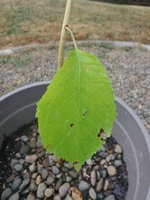DavidBoren
Mame
This was growing out of some bushes in the front yard.

I used garden hose hydraulic fracturing to remove the soil around the roots, and pulled it up... the tree had some decent roots, I already had the pot just sitting around, and the soil was actually already in the pot. Said soil is an organic mix of different soils taken from the pots of trees that didn't survive the summer, so it is fertile and moist and relatively decent as far as organic soil goes.
Anyways, Google Lens suggests Elm...



I used garden hose hydraulic fracturing to remove the soil around the roots, and pulled it up... the tree had some decent roots, I already had the pot just sitting around, and the soil was actually already in the pot. Said soil is an organic mix of different soils taken from the pots of trees that didn't survive the summer, so it is fertile and moist and relatively decent as far as organic soil goes.
Anyways, Google Lens suggests Elm...




